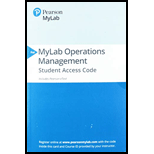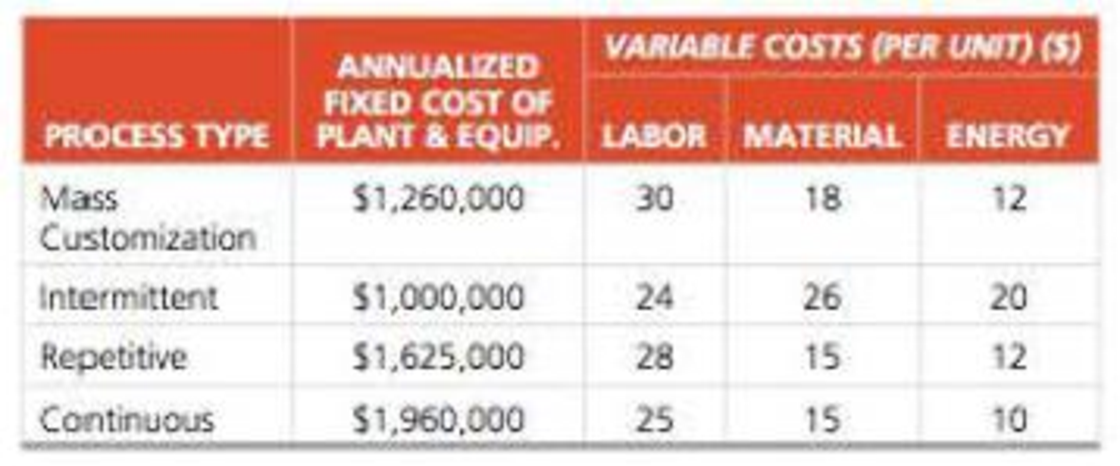
Metters Cabinets, Inc., needs to choose a production method for its new office shelf, the Maxistand. To help accomplish this, the firm has gathered the following production cost data:

Metters Cabinets projects an annual demand of 24,000 units for the Maxistand. The Maxistand will sell for $120 per unit. a) Which process type will maximize the annual profit from producing the Maxistand?
b) What is the value of this annual profit?
a)
To determine: The process type that will maximize the annual profit by producing the Maxistand.
Answer to Problem 9P
The process type that will maximize the annual profit by producing the Maxistand is the intermittent process.
Explanation of Solution
Given information:
| Process type | Annual fixed cost of plant & equip |
Variable costs (Per Unit) ($) | ||
| Labor | Material | Energy | ||
| Mass customization | $1,260,000 | 30 | 18 | 12 |
| Intermittent | $1,000,000 | 24 | 26 | 20 |
| Repetitive | $1,625,000 | 28 | 15 | 12 |
| Continuous | $1,960,000 | 25 | 15 | 10 |
Annual demand = 24,000 units
Maxistand selling price = $120 / unit
Calculation of number of units:
Let ‘x’ be the number of units. The units is calculated by multiplying annual fixed cost with ‘x’ and summing with the total variable cost and equating it with multiplying the Maxistand selling price with ‘x’.
Mass customization:
Intermittent:
Repetitive:
Continuous:
Identifying least cost process at x = 24000 units:
The least cost is calculated by multiplying variable cost with the value of ‘x’ and summing it with the annual fixed cost.
Mass customization:
Intermittent:
Repetitive:
Continuous:
The cost is lower for intermittent process ($2,680,000) with the break-even point of 20,000. The intermittent process will increase the annual profit.
Hence, the best process is the intermittent process.
b)
To determine: The annual profit by following the intermittent process.
Answer to Problem 9P
The annual profit is $200, 000
Explanation of Solution
Given information:
| Process type | Annual fixed cost of plant & equip |
Variable costs (Per Unit) ($) | ||
| Labor | Material | Energy | ||
| Mass customization | $1,260,000 | 30 | 18 | 12 |
| Intermittent | $1,000,000 | 24 | 26 | 20 |
| Repetitive | $1,625,000 | 28 | 15 | 12 |
| Continuous | $1,960,000 | 25 | 15 | 10 |
Annual demand = 24,000 units
Maxistand selling price = $120 / unit
Calculation of number of units:
Let ‘x’ be the number of units. The units is calculated by multiplying annual fixed cost with ‘x’ and summing with the total variable cost and equating it with multiplying the Maxistand selling price with ‘x’.
Mass customization:
Intermittent:
Repetitive:
Continuous:
Identifying least cost process at x = 24000 units:
The least cost is calculated by multiplying variable cost with the value of ‘x’ and summing it with the annual fixed cost.
Mass customization:
Intermittent:
Repetitive:
Continuous:
Calculation of annual profit:
The annual profit is calculated by multiplying the selling price with annual demand and subtracting it from the cost of the intermittent process.
The annual profit is $200, 000.
Want to see more full solutions like this?
Chapter 7 Solutions
EBK PRINCIPLES OF OPERATIONS MANAGEMENT
- Prepare a master schedule given this information: The forecast for each week of an eight-week schedule is 60 units. The MPS rule is to schedule production if the projected on-hand Inventory would be negative without it. Customer orders (committed) are as follows: Week Customer Orders 1 2 36 28 4 1 Use a production lot size of 85 units and no beginning inventory. Note: In the ATP row, enter a value of 0 (zero) in any periods where ATP should not be calculated. Leave no cells blank - be certain to enter "0" wherever required. June July 1 2 3 4 5 8 7 8 Forecast 60 60 60 60 60 60 60 60 Customer Orders 38 28 4 1 0 0 0 0 Projected On-Hand Inventory MPS ATParrow_forwardSales of tablet computers at Marika Gonzalez's electronics store in Washington, D.C., over the past 10 weeks are shown in the table below: Week 1 2 3 4 5 6 7 8 9 10 Demand 21 21 27 38 25 30 35 24 25 30 a) The forecast for weeks 2 through 10 using exponential smoothing with a = 0.50 and a week 1 initial forecast of 21.0 are (round your responses to two decimal places): Week 1 2 3 4 5 6 7 8 9 10 Demand 21 21 27 38 25 30 35 24 25 30 Forecast 21.0 21 21 24 31 28 29 32 28 26.50 b) For the forecast developed using exponential smoothing (a = 0.50 and initial forecast 21.0), the MAD = |||||sales (round your response to two decimal places).arrow_forwardSales of tablet computers at Marika Gonzalez's electronics store in Washington, D.C., over the past 10 weeks are shown in the table below: Week Demand 1 2 3 4 5 6 7 8 9 10 21 21 27 38 25 30 35 24 25 30 a) The forecast for weeks 2 through 10 using exponential smoothing with a = 0.50 and a week 1 initial forecast of 21.0 are (round your responses to two decimal places): Week 1 2 3 4 5 Demand 21 21 27 38 Forecast 21.0 ☐ G ☐ ☐ 6 7 25 30 35 ∞ ☐ 8 9 10 24 25 30arrow_forward
- Each machine costs $3 Million. Building the room with all its attendant safety protection and other ancillary costs increases the spending by an additional $2.0 million dollars per MRI suite. Each machine can perform 2000 scans per year. Each reading of an MRI scan by a radiologist, along with other per-scan-related costs, is $500 per scan. The machine will last five years. Don’t worry about discount rates for this problem Graph the total costs over 5 years as a function of sales for 0-3000 patients annually. Hint: you may need to add a second MRI at some point. Suppose that you want to make a profit of $500 per scan at a target volume of 1000 patients per year, and you purchase only one machine. Superimpose the total revenue curve on top of the total cost curve in (1).arrow_forwardI need the answer to requirement C.arrow_forwardImagine you are Susan Kim and are faced with a difficult choice to either follow the orders she was given, or refusing to do so. Using each lens determine what the ethical response would be. Suppot your answer with materials from readings and lectures. For example, using Universalism what would the ethical response be? Do the same for all four lenses.arrow_forward
- Answer all these questions, selecting any company of your choice. Choose a specific type of food company. Select a specific product. Develop all the inputs that are part of the process. Develop the transformation process in a graphic (diagram, etc.). Develop all the outputs or finished products that are part of the process. Describe all the processes involved in one line of production in any manufacturing facility. Also describing how good management is the center of any part of a production company.arrow_forwardUsing exponential smoothing with α =0.2, forecast the demand for The initial forecast for January is 2000 tons. Calculate the capacity utilization for June, July and Discuss the implications of underutilized or over utilized capacity for Green Harvestarrow_forwardIn organizational development when results are improving but relationships are declining, what leadership style is appropriate? directing delegating supporting coachingarrow_forward
- What is the first thing a leader should do when moving through a cultural change? conduct an assessment comparing the practices to other high-performing organizations learn about the current organizational culture continue to monitor key metrics define expectationsarrow_forwardThe third change leadership strategy, Collaborate on Implementation, is designed to address what type of concerns? impact concerns personal concerns refinement concerns collaboration concernsarrow_forwardIf team members are concerned with specifics such as their tasks, contingency plans, resources, and timeline, what concerns do they have? implementation concerns impact concerns refinement concerns personal concernsarrow_forward
 Practical Management ScienceOperations ManagementISBN:9781337406659Author:WINSTON, Wayne L.Publisher:Cengage,MarketingMarketingISBN:9780357033791Author:Pride, William MPublisher:South Western Educational Publishing
Practical Management ScienceOperations ManagementISBN:9781337406659Author:WINSTON, Wayne L.Publisher:Cengage,MarketingMarketingISBN:9780357033791Author:Pride, William MPublisher:South Western Educational Publishing Contemporary MarketingMarketingISBN:9780357033777Author:Louis E. Boone, David L. KurtzPublisher:Cengage Learning
Contemporary MarketingMarketingISBN:9780357033777Author:Louis E. Boone, David L. KurtzPublisher:Cengage Learning Purchasing and Supply Chain ManagementOperations ManagementISBN:9781285869681Author:Robert M. Monczka, Robert B. Handfield, Larry C. Giunipero, James L. PattersonPublisher:Cengage Learning
Purchasing and Supply Chain ManagementOperations ManagementISBN:9781285869681Author:Robert M. Monczka, Robert B. Handfield, Larry C. Giunipero, James L. PattersonPublisher:Cengage Learning Management, Loose-Leaf VersionManagementISBN:9781305969308Author:Richard L. DaftPublisher:South-Western College Pub
Management, Loose-Leaf VersionManagementISBN:9781305969308Author:Richard L. DaftPublisher:South-Western College Pub





